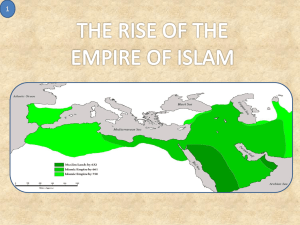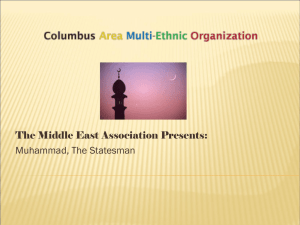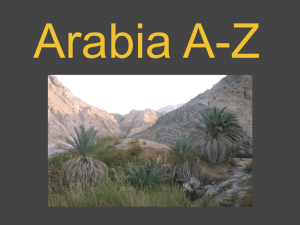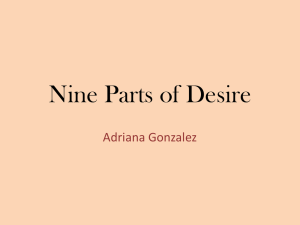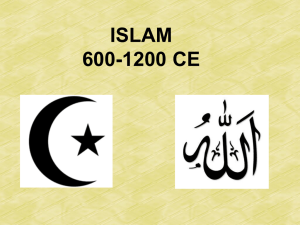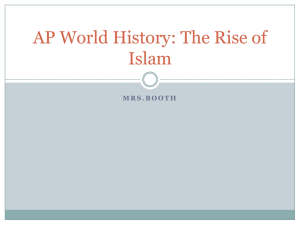Ch. 3 PPT
advertisement
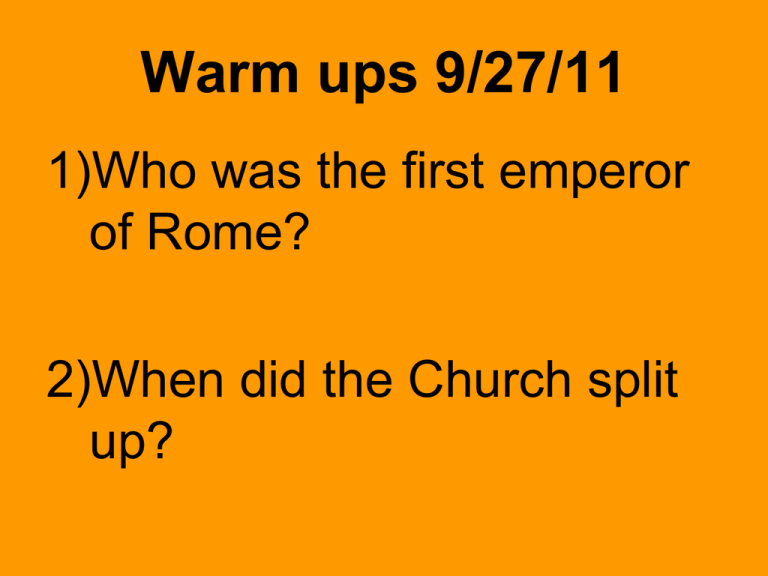
Warm ups 9/27/11 1)Who was the first emperor of Rome? 2)When did the Church split up? • Explore the Art • In this scene, the young ruler of the Islamic Mughal Empire, Akbar the Great, leaves his palace on a hunting trip. What does this scene show about Akbar’s life? Warm ups 9/28/11 1)Explain where you would see an oasis. 2)Describe a nomadic lifestyle. Turn to pg. 54 and NB pg. 13 Main ideas 1.Arabia is mostly a desert land. 2.Two ways of life—nomadic and sedentary—developed in the desert. The Big Idea • Life in Arabia was influenced by the harsh desert climate of the region. Key Terms / Vocabulary • • • • • sand dunes oasis •Muhammad sedentary •Islam caravan •Muslim Souk •Qur’an •shrine •pilgrimage •mosque •jihad •Sunnah •Five Pillars of Islam Academic Vocab •Features •influence sand dunes oasis sedentary caravan Souk Wet land in a desert Hills of sand A middle eastern market place A group of people Traveling together. Not moving around sand dune a hill of sand shaped by the wind oasis a wet, fertile area within a desert sedentary settled caravan a group of traders that travel together souk (SOOK) a market or bazaar in the Islamic world Group activities • Each table will be given a red/blue section to read and then report back to class • Please write down some bullets to tell the class • When you are done, you will write them on the board Here they are……….by table 1) 2) 3) 4) 5) 6) 7) 8) A desert land A Crossroads Location Physical features Desert Climate Two ways of life Nomads Townspeople Trade Centers A Desert Land • The Arabian Peninsula, or Arabia, is mostly a hot and dry desert land. Scorching temperatures and a lack of water make life difficult. But in spite of the difficulty, people have lived in Arabia for thousands of years. During this time, Arabia’s location, physical features, and climate have shaped life in the region. A Crossroads Location • The Arabian Peninsula is located in the southwest corner of Asia. As you can see on the map, it lies near the intersection of three continents—Africa, Asia, and Europe. Trade routes linking the three continents have passed through the region for thousands of years. Geographers call Arabia a “crossroads” location. • Merchants carried goods such as spices, silk, and gold along the trade routes. Some of these trade routes were on land. Others were water routes along the coast or across the seas. Trade brought many different groups of people through Arabia. These people introduced products and ideas from around the world, influencing Arabian culture and society. Physical Features • Arabia’s location has also shaped its physical features. It lies in a region with hot and dry air. This climate has created a band of deserts across Arabia and northern Africa. Huge, sandy deserts cover large parts of Arabia. Sand dunes, or hills of sand shaped by the wind, can rise to 800 feet high and stretch for hundreds of miles! The world’s largest sand desert, the Rub' al-Khali (ROOB ahl-KAH-lee), covers much of southern Arabia. Rub' al-Khali means “Empty Quarter,” a name given to the desert because there is so little life there. • Arabia’s deserts have a very limited amount of water. There are no permanent lakes or rivers. Water exists mainly in oases scattered across the deserts. An oasis is a wet, fertile area in a desert. These wet areas form where underground water bubbles to the surface. Oases have long been key stops along Arabia’s overland trade routes. • Although deserts cover much of the interior of Arabia, other landforms appear along the edges of the peninsula. Mountains border the southern and western coasts, and marshy land lies near the Persian Gulf. Most of the settlement in Arabia has been in these milder coastal regions. Desert Climate • Arabia is one of the hottest, driest places in the world. With a blazing sun and clear skies, summer temperatures in the interior reach 100°F daily. This climate makes it hard for plants and animals to survive. • Desert plants do live in areas that get little rain. Many of them have roots that stretch deep or spread out far to collect as much water as possible. Just as plants have adapted to life in Arabia, so too have people found ways to live there. • Summarizing • What are the main physical features of Arabia’s environment? Two Ways of Life • To live in Arabia’s difficult desert environment, people developed two main ways of life. Some people lived a nomadic life, moving from place to place. Others lived a sedentary, or settled, life in towns. Nomads • Nomads lived in tents and raised herds of sheep, goats, and camels. The animals provided milk, meat, and skins for the nomads’ tents. Nomads traveled with their herds across the desert, moving along regular routes as seasons changed, to get food and water for their animals. They depended on camels for transportation and milk. • Among the nomads, camels and tents belonged to individuals. Water and grazing land belonged to tribes. Membership in a tribe, a group of related people, was important to nomads. The tribe offered protection from desert dangers, such as violence that often took place when people competed for water and grazing land. Townspeople • While nomads moved around the desert, other people settled in oases where they could farm. These settlements, particularly the ones in oases along trade routes, became towns. Most people in Arabia lived in towns. Merchants and craftspeople lived there and worked with people in the caravan trade. A caravan is a group of traders that travel together. Trade Centers • Towns became centers of trade for both nomads and townspeople. Many towns had a souk (SOOK)—a market or bazaar. In the market, nomads traded animal products and desert herbs for goods such as cooking supplies and clothing. Merchants sold spices, gold, leather, and other goods brought by the caravans. • Arabian towns were important stations on the trade routes linking India with Northeast Africa and the Mediterranean. Trade brought Arabs into contact with people and ideas from around the world. SUMMARY AND PREVIEW • The geography of Arabia encouraged trade and influenced the development of nomadic and sedentary lifestyles. In the next section, you will read about a religion that began to influence many people in Arabia. Textbook pg 58 –NB pg. 14 Show differences and similarities between nomadic and sedentary lifestyles in Arabia. Sedentary Nomadic Section 2 Origins of Islam Pg. 59 The Big Idea Muhammad, a merchant from Mecca, introduced a major world religion called Islam. The Main Ideas 1. Muhammad became a prophet and introduced a religion called Islam in Arabia. 2. Muhammad’s teachings had similarities to Judaism and Christianity, but they also presented new ideas. 3. Islam spread in Arabia after being rejected at first. Ca Standards 7.2.2 Trace the origins of Islam and the life and teachings of Muhammad, including Islamic teachings on the connection with Judaism and Christianity. Key Terms • • • • • • • Muhammad Islam Muslim Qur’an shrine pilgrimage mosque Muhammad • (c. 570–632) Founder of Islam, he spread Islam’s teachings to the people of Arabia. His teachings make up the Qu’ran. Islam • a religion based on the messages Muhammad is believed to have received from God Muslim •a follower of Islam Qur’an • Muslims believe that Muhammad continued receiving messages from God for the rest of his life. These messages were collected in the Qur’an (kuh-RAN), the holy book of Islam. shrine •a place at which people worship a saint or god pilgrimage •a journey to a sacred place mosque •(MAHSK) a building for Muslim prayer • If YOU were there... You live in a town in Arabia, in a large family of wealthy merchants. Your family’s house is larger than most others in the town. You have beautiful clothes and many servants to wait on you. Many townspeople are poor, but you have always taken such differences for granted. Now you hear that some people are saying the rich should give money to the poor. • How might your family react to this idea? • BUILDING BACKGROUND • The idea that people should help the poor is one important teaching of a religion called Islam. When Islam was introduced to the people of Arabia, many of its teachings seemed new and different. Muhammad Becomes a Prophet • A man named Muhammad brought a different religion to the people of Arabia. Historians don’t know much about Muhammad. What they do know comes from religious writings. Muhammad’s Early Life • Muhammad was born into an important family in Mecca around 570. Muhammad’s early life was not easy. His father, a merchant, died before he was born; and his mother died later, when he was six. CONT. • With his parents gone, Muhammad was first raised by his grandfather and later by his uncle. When he was a child, he traveled with his uncle’s caravans, visiting places such as Syria and Jerusalem. Once he was grown, he managed a caravan business owned by a wealthy woman named Khadijah (ka-DEE-jah). Eventually, at age 25, Muhammad married Khadijah. CONT. • The caravan trade made Mecca a rich city. But most of the wealth belonged to just a few people. Poor people had hard lives. Traditionally, wealthy people in Mecca had helped the poor. But as Muhammad was growing up, many rich merchants began to ignore the poor and keep their wealth for themselves. • Three Religions • The three main monotheistic religions in the world are Judaism, Christianity, and Islam. Each religion has its own particular beliefs and practices. Yet they also have important similarities. For example, all three began in the same part of the world—Southwest Asia. Also, all three religions teach similar ideas about kindness to fellow people and belief in one God. A Message for Muhammad • Concerned about the changing values in Mecca, Muhammad often went by himself to the hills outside the city to pray and meditate. One day, when he was about 40 years old, Muhammad went to meditate in a cave. Then, according to Islamic teachings, something happened that changed his life forever. An angel appeared and spoke to Muhammad, telling him to “Recite! Recite!” Confused at first, Muhammad asked what he should recite. The angel answered: Message Cont. • “Recite in the name of your Lord who created, created man from clots of blood! Recite! Your Lord is the Most Bountiful One, Who by the pen taught man what he did not know.” Message Cont. • Muslims believe that God had spoken to Muhammad through the angel and had made him a prophet, a person who tells of messages from God. At first Muhammad was afraid and didn’t tell anyone except his wife about the voice in the cave. A few years later, in 613, Muhammad began to tell other people about the messages. Message Cont. • The messages Muhammad received form the basis of the religion called Islam. The word Islam means “to submit to God.” A follower of Islam is called a Muslim. Muslims believe that Muhammad continued receiving messages from God for the rest of his life. These messages were collected in the Qur’an (kuh-RAN), the holy book of Islam. Muhammad’s Teachings • Not all of Muhammad’s early teachings were new. In fact, some were much like the teachings of Judaism and Christianity. But Muhammad’s teachings challenged and upset the people of Arabia. These teachings brought changes to many aspects of life in Arabia. A Belief in One God • Muhammad taught that there was only one God, Allah, which means “the God” in Arabic. In that way, Islam is like Judaism and Christianity. It is a monotheistic religion, a religion based on a belief in one God. Although people of all three religions believe in one God, their beliefs about God are not all the same. Belief cont. • Jews, Christians, and Muslims also recognize many of the same prophets. Muhammad taught that prophets such as Abraham, Moses, and Jesus had lived in earlier times. Unlike Christians, Muslims do not believe Jesus was the son of God, but they do believe many stories about his life. Muhammad told stories about these prophets similar to the stories in the Torah and the Christian Bible. Muhammad respected Jews and Christians as “people of the Book” because their holy books taught many of the same ideas that Muhammad taught. A Challenge to Old Ideas • Some of Muhammad’s teachings would have seemed familiar to Jews and Christians, but they were new to most Arabs. • For example, most people in Arabia believed in many different gods, a belief system called polytheism. Challenge cont. • Before Muhammad told them to believe in one God, Arabs worshipped many gods and goddesses at shrines. A shrine is a place at which people worship a saint or a god. A very important shrine, the Kaaba (KAH-buh), was in Mecca. People traveled there every year on a pilgrimage, a journey to a sacred place. Challenge cont. • Several of Muhammad’s teachings upset many Arabs. First, they didn’t like being told to stop worshipping their gods and goddesses. Second, Muhammad’s new religion seemed like a threat to people who made money from the yearly pilgrimages to the Kaaba. Mecca’s powerful merchant leaders thought they would lose business if people didn’t worship their gods at the Kaaba. Challenge cont. • Another of Muhammad’s teachings also worried Mecca’s wealthy merchants. Muhammad said that everyone who believed in Allah would become part of a community in which rich and poor would be equal. But the merchants wanted to be richer and more powerful than the poor people, not equal to them. Challenge cont. • Muhammad also taught that people should give money to help the poor. However, many wealthy merchants didn’t want to help the poor. Instead, they wanted to keep all of their money. Because many of the people in Mecca didn’t want to hear what Muhammad had to say, they rejected his teachings. Islam Spreads in Arabia • At first Muhammad did not have many followers. Mecca’s merchants refused to believe in a single God and rejected the idea of equality. They even made Muhammad leave Mecca for a while. Eventually, however, Muhammad’s teachings began to take root. From Mecca to Medina • Slowly, more people began to listen to Muhammad’s ideas. But as Islam began to influence people, the rulers of Mecca became more and more worried. They began to threaten Muhammad and his small group of followers with violence. They even planned to kill Muhammad. As a result, Muhammad had to look for support outside of Mecca. Mecca to Medina cont. • A group of people from a city north of Mecca invited Muhammad to live in their city. As the threats from Mecca’s leaders got worse, Muhammad accepted the invitation. In 622 he and many of his followers, including his daughter Fatimah, left Mecca and went to Medina (muhDEE-nuh). Named after Muhammad, Medina means “the Prophet’s city” in Arabic, the language of the Arabs. Muhammad’s departure from Mecca became known in Muslim history as the hegira (hi-JY-ruh), or journey. From Medina to the Rest of Arabia • Muhammad’s arrival in Medina holds an important place in Islamic history. There he became both a spiritual and a political leader. His house became the first mosque (MAHSK), or building for Muslim prayer. The year of the hegira, 622, became so important to the development of Islam that Muslims made it the first year in the Islamic calendar. Rest of Arabia cont. • According to Islamic belief, in Medina Muhammad reported new revelations about rules for Muslim government, society and worship. For example, God told Muhammad that Muslims should face Mecca when they pray. Before, Muslims faced Jerusalem like Christians and Jews did. Muslims recognized the importance of Mecca as the home of the Kaaba. They believe the Kaaba is a house of worship that Abraham built and dedicated to the worship of one God. Rest of Arabia cont. • As the Muslim community in Medina grew stronger, other Arab tribes in the region began to accept Islam. However, conflict with the Meccans increased. In 630, after several years of fighting, the people of Mecca gave in. They welcomed Muhammad back to the city and accepted Islam as their religion. • In Mecca Muhammad and his followers destroyed the statues of the gods and goddesses in the Kaaba. Soon most of the Arabian tribes accepted Muhammad as their spiritual leader and became Muslims. Rest of Arabia cont. • Muhammad died in 632 at his home in Medina. Although he didn’t live long after Mecca became Muslim, the religion he taught would soon spread to lands far beyond Arabia. • Muhammad taught that there was only one God. This Arabic writing says “There is no god but God, and Muhammad is his prophet.” • Mosque in Medina SUMMARY AND PREVIEW • You have just read about some of Muhammad’s teachings and how people in Arabia reacted to them. Many people in Arabia accepted Islam and became Muslims. In the next section, you will learn more about the main Islamic teachings and beliefs. Complete question #4 on pg 64 from your textbook In your history notebook identify key dates in Muhammad’s life by completing this timeline.
